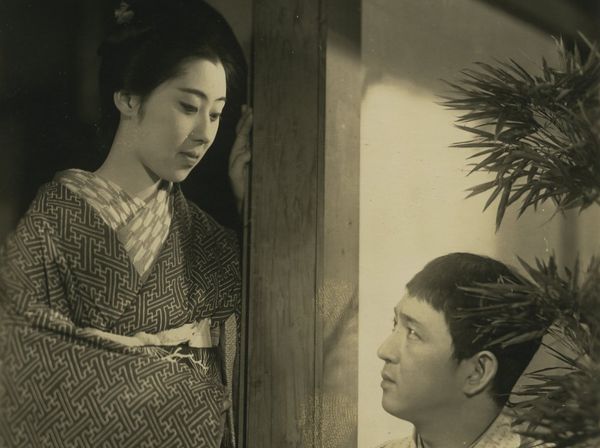ORIZURU OSEN
[La caduta di Osen / The Downfall of Osen]
Kenji Mizoguchi (JP 1935)
Melodrama was among the most characteristic genres of the Japanese cinema of the early 1930s, and author Kyoka Izumi (1873-1939) was, claims Inuhiko Yomota, “the richest source of this mode of film expression”. Following on from the lost Bridge of Japan (Nihonbashi, 1929), and the extant Cascading White Threads (Taki no shiraito, 1933), The Downfall of Osen is Mizoguchi’s third adaptation of a literary work by Izumi, whom he apparently respected sufficiently to visit personally in order to solicit advice about how to adapt his stories.
All three narratives are set largely or wholly during the Meiji Era (1868-1912), and focus on women who sacrifice themselves for male friends or relatives. Mizoguchi, who throughout his career would dramatize the sufferings and oppression of Japanese women, may have found Izumi’s thematic concerns congenial. The Downfall of Osen is based on Izumi’s 1920 novel Baishoku kamo nanban. The original title combines a reference to prostitution with the name of a noodle dish flavoured with duck and spring onions; Mizoguchi was obliged to change it, he said, because “it was a little too obscene”. The title indicates the theme: a woman prostitutes herself in order to support her lover’s studies as a medical student, ironically destroying in the process her own health and sanity.
Mizoguchi himself felt that the film “failed to evoke the quality of the original work”, and it has not generally been ranked among his finest achievements. Yet while Tadao Sato criticizes it as “incoherent and inconsistent”, he nevertheless proclaims it “a wonderful film” on the basis of its highlights: “the scenes of Sokichi and Osen’s first meeting, their parting, their reunion, and for the last scene with the mad Osen”. One might add praise for the inventive use of flashbacks, and for the visual flamboyance of the best scenes: both features are apparent in the bravura opening sequence, which cuts between two time frames and between different weather conditions.
In its visual approach the film occupies a transitional position in Mizoguchi’s oeuvre analogous to its place between silent and sound film. There are a number of unusually long takes (albeit necessarily interrupted by intertitles) and shots where the camera is kept at a relative distance from the action, although other scenes, perhaps more typical of late silent cinema, are rapidly edited and make use of flamboyant (in this case perhaps somewhat undisciplined) camera movement. At this stage in his career Mizoguchi had not achieved the choreographic precision that was to mark his films in the late 1930s, but (despite the scarred condition of the surviving copies) his stylistic flair and atmospheric precision are already apparent. Indeed, Chika Kinoshita argues that “The sound transition was not mere historical background to Mizoguchi’s film style but, rather, had a decisive, formative influence.”
By early 1935, when the film was released, sound films were making steady inroads into Japanese cinema, although it would not be until the following year that they constituted the majority of films released in Japan. Although Mizoguchi had made his first sound film, Hometown (Furusato), as early as 1930, almost all of his films of the first half of the decade were silent. The Downfall of Osen was intended as a full talkie; only because the sound equipment did not arrive on time was it shot silent. It was released with a pre-recorded benshi commentary by Suisei Matsui, and a musical score, selected by Matsui, drawing on Western orchestral standards such as Mussorgsky’s Night on Bald Mountain. Matsui was a respected benshi who had narrated foreign silent films at one of Tokyo’s most prestigious theatres, but contemporary critics judged Matsui’s commentary anachronistic, coming soon after benshi were retired from first-run theatres; as Kinoshita reports, “The reviewers at both Kinema Junpo and Eiga Hyoron dismissed Matsui’s performance as a hindrance to an otherwise moving or at least interesting film. Most tellingly, the manager of Asahiza, one of the theaters where the film opened in Osaka, turned off the sound and thereby achieved a two-week run.” The film was Mizoguchi’s last saundo-ban; he moved definitively to full talkies thereafter.
Star Isuzu Yamada (1917-2012), who was just short of her 18th birthday at the time of the film’s release, was making her second appearance in a film by Mizoguchi (after the now-lost Mountain Pass of Love and Hate / Aizo toge, 1934). She commented on the contrast between the director’s kindness off-set and his ruthlessness while filming: “for long hours,” she remarked, “I had my head stuck in a washing bowl, half-alive and half-dead.” But she went on to observe that Mizoguchi was an example of a director whose relationship with his star, however acrimonious on the surface, could “sparkle inside”. Certainly, she went on to give some of the finest performances of her career in Mizoguchi’s superb 1936 diptych of Osaka Elegy (Naniwa erejii) and Sisters of the Gion (Gion no kyodai).
Alexander Jacoby & Johan Nordström

regia/dir: Kenji Mizoguchi.
scen: Tatsunosuke Takashima.
sogg./story: Kyoka Izumi.
photog: Minoru Miki.
scg.des: Yoshiji Oguri.
mus, narr: Suisei Matsui.
cast: Isuzu Yamada (Osen), Daijiro Natsukawa (Sokichi), Shin Shibata (Kumazawa), Genichi Fujii (Matsuda), Mitsuru Tojo (Amadani), Eiji Nakano (professor), Junichi Kitamura (Heishiro), Shizuko Takizawa (Osode), Sue Ito (nonna di Sokichi/Sokichi’s grandmother).
prod: Daiichi Eiga.
copia/copy: 35mm, 2390 m., 87′ (24 fps); did/titles: JPN.
fonte/source: National Film Archive of Japan, Tokyo.


 Italiano
Italiano